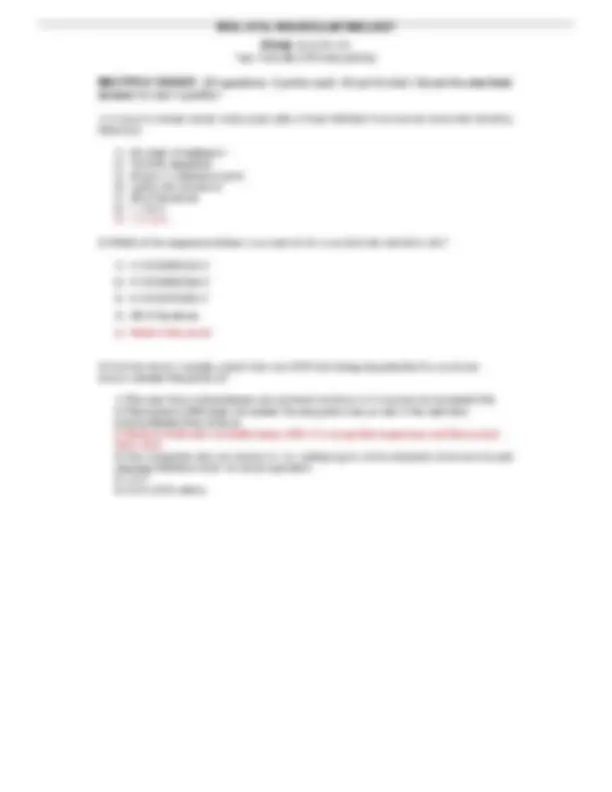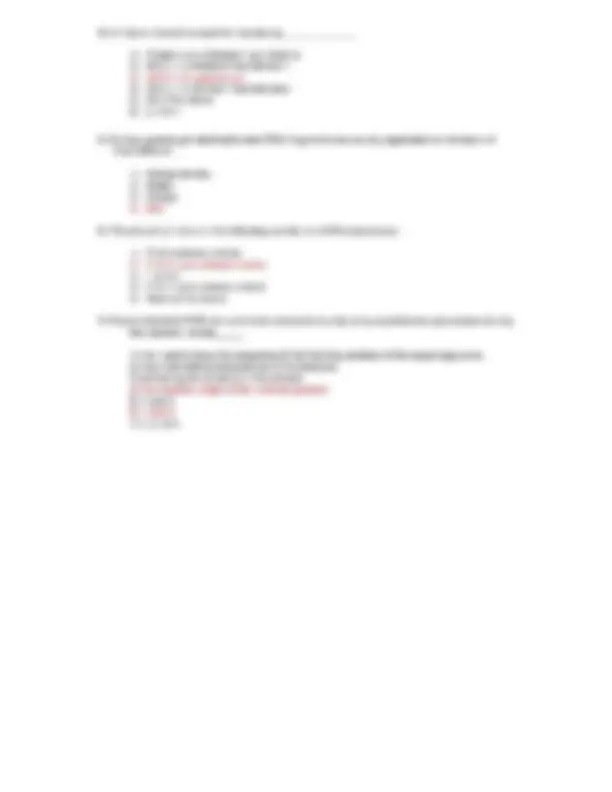Partial preview of the text
Download Practise Exams for Final and more Exams Molecular biology in PDF only on Docsity!
An RNA primer is formed starting at the underlined T (T) of the template. Which of the following represents the primer sequence? - Correct Answers 5'AGCUUACC3' Accuracy in the translation of mRNA into the primary structure of a polypeptide depends on specificity in the - Correct Answers bonding of the anticodon to the codon and the attachment of amino acids to tRNAs A mutant bacterial cell has a defective aminoacyl-tRNA synthetase that attaches a lysine to tRNAs with the anticodon AAA instead of the normal phenylalanine. The consequence of this for the cell will be that - Correct Answers proteins in the cell will include lysine instead of phenylalanine at amino acid positions specified by the codon UUU When translating secretory or membrane proteins, ribosomes are directed to the ER membrane by - Correct Answers a signal-recognition particle that brings ribosomes to a receptor protein in the ER membrane Which of the following DNA mutations is the least likely to be damaging to the protein it specifies? - Correct Answers a substitution in the last base of a codon The figure below demonstrates the outcome of the following type of mutation: - Correct Answers frameshift causing extensive missense” Which of the following does not occur in prokaryotic gene expression, but does in eukaryotic gene expression? - Correct Answers A poly-A tail is added to the 3' end of an mRNA and a cap is added to the 5' end. The average length of a transcription unit along a eukaryotic DNA molecule is about 27kb nucleotide pairs, whereas an averaged- sized protein is about 400 amino acids long. What is the best explanation for this fact? - Correct Answers most eukaryotic genes and their RNA transcripts have long noncoding stretches of nucleotides that are not translated The tryptophan operon is a repressible operon that is - Correct Answers turned off whenever tryptophan is added to the growth medium If you were to observe the activity of methylated DNA, you would expect it to - Correct Answers have turned off or slowed down the process of transcription bio 203 final exam Questions & Answers(GRADED A) RNA polymerase - ANSWER pries the two strands of DNA apart and joins the RNA nucleotides as they base-pair along the DNA templates promoter - ANSWER DNA sequence where RNA polymerase attaches and initiates transcription Synthesis of RNA transcript - ANSWER initiation; elongation; termination synthesis of RNA transcript initiation - ANSWER after RNA polymerase binds to the promoter, the DNA strands unwind, and the polymerase initiates RNA synthesis at the start point of the template strand synthesis of RNA transcript elongation - ANSWER the polymerase moves downstream, unwinding DNA and elongating RNA transcript 5 to 3; in wake of transcription, the DNA strands reform a double helix transcription factors - ANSWER help eukaryotic RNA polymerase recognize promoter sequences 5 cap - ANSWER modified form of guanine is added onto the 5 end after transcription of the first 20-40 nucleotides poly-A tail - ANSWER at the 3 end, and enzyme adds 50-250 adenine nucleotides forming a tail RNA processing - ANSWER enzymes in the nucleus modify pre mRNA in specific ways before the genetic messages are dispatched to the cytoplasm; introns are spliced out; the ends of the primary transcript are altered Eukaryotic RNA splicing - ANSWER removes introns and joins exons spliceosome - ANSWER mediates RNA splicing; made of several snRNPs joined with additional proteins ribozymes - ANSWER catalytic RNA molecules that function as enzymes and can splice RNA alternative RNA splicing - ANSWER introns allow more than one polypeptide to be formed, since different exons can be joined together during splicing 2. True or false. There is a close correlation between genome size (in kbp) and complexity of organisms. a.True _ b. False 3. True or False. Yeast, even though it is a eukaryote has only ~ 40% more genes than E. coli. a.True _ b. False 4. The smallest genome known for a self-replicating, free living organism is a. found in an archaeote b. found in a prokaryote c. 517 genes daand c e.band c 5. Integration of exogenous (extemal) DNA into the nuclear genome in mammalian cells usually involves a. homologous recombination b. non-homologous recombination. c. similar sequences in the integrating DNA and in the genome target d botha and c 6. What is the function of the neo gene in a typical mammalian transformation vector? a. makes cells susceptible to gangcyclovir b. provides neomycin resistance to cells transformed by homologous recombination c. provides neomycin resistance to cells transformed by non-homologous transformation d both b and c¢ e. all of the above 7. True or False. In a knock-out mouse, a normal gene is replaced with a disrupted gene. a.True _ b, false 8. The first mouse generated in the process of making a knock-out mouse is usually a. completely normal b. homozygous for the KO gene in some cells, but not others c. heterozygous for the KO gene in some cells, but not others d. none of the above BIOL 3774, MOLECULAR BIOLOGY EXAM Il (3-21-12) Test Form B (120 total points). MULTIPLE CHOICE (20 questions, 3 points each, 60 points total.) Select the one best answer for each question. 1) In order to remain viable inside yeast cells a Yeast Artificial Chromosome needs the following feature(s): An origin of replication Telomer sequence Ampicillin resistance gene Centromer sequence All of the above 1,283. 1,2,&4. YEBsLerve 2) Which of the sequences below is an example for a palindromic restriction site? 5'-GCGAAGCG-3’ 5'-GCGAGCGA-3’ ) 2) ) 5-GCGATCGG-3' ) ) wo 4) 5 All of the above None of the above 3) How do bacteria usually protect their own DNA from being degraded by the restriction endonucleases they produce? 1) The restriction endonucleases are secreted and thus don’t degrade the bacterial DNA. 2) The bacterial DNA does not contain the recognition sequences of the restriction endonucleases they produce. 3) Bacteria methylate nucleotide bases within the recognition sequences and thus protect these sites. 4) The recognition sites are located in non-coding regions of the bacterial chromosomes and cleavage therefore does not cause a problem. 5) 3&4 6) None of the above. 

















